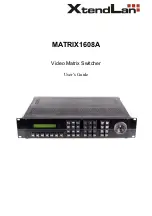
1-6
8237 Hub Installation and Planning Guide
Understanding Expansion Ports
There are two types of optional Expansion Ports available for the 8237, Media
Expansion Ports and Fast Expansion Modules.
Media Expansion Ports (MEPs)
MEPs provide a way to connect the 8237 Hub directly to additional networks over
other Ethernet media types. An MEP thus extends the collision domain of the 8237
to another network. These Expansion Ports and their connected network segments
become part of the same collision domain as that of the 8237.
There are two kinds of MEPS: AUI/10BASE2 and 10BASE-FL/FOIRL. The
AUI/10BASE2 MEP will accept an Ethernet transceiver or 10BASE2 coaxial cabling.
The ST connectors of the 10BASE-FL/FOIRL MEP will accept standard 62.5/125-
micrometer optical fiber cables. Both of these expansion ports support connection
to only 10-Mbps Ethernet networks.
Fast Expansion Modules (FEMs)
The 10BASE-T/100BASE-TX and 100BASE-FX FEMs enable the 8237 to connect
to another 10-Mbps Ethernet collision domain or to 100-Mbps Fast Ethernet. When
installed, these Expansion Ports act as two-port Ethernet switches that provide
isolation between the collision domain in the 8237 and the collision domain in the
attached network, while maintaining communication between the collision domains.
FEMs can be connected to a subnetwork, directly to a server, bridge, or router, or to
another 8237 in the stack that has been configured to be in a different segment.
Two 10BASE-T/100BASE-TX FEMs in an 8237 stack can serve as bridges, joining
three segments. This approach shares network load across three 10-Mbps collision
domains within the stack yet still enables communication among all workstations.
The 10BASE-T/100BASE-TX FEM supports connection to either 10-Mbps or 100-
Mbps networks (auto-negotiating). It supports either full-duplex or half-duplex
transmission. The transmission mode selection is also auto-negotiating.
The switch interface in both types of FEMs provides:
•
160-KB port buffer.
•
Automatic filtering on destination addresses.
•
Source address self-learning (4000 addresses per port). Addresses age out
after five minutes.
•
Two selectable forwarding modes: store-and-forward and adaptive cut-through.
In store-and-forward mode, the FEM receives the entire frame before forwarding it.
In adaptive cut-through mode, the FEM dynamically adjusts the forwarding mode
between store-and-forward, fragment-free cut-through, and cut-through. Which
mode is used depends on interface speeds and network conditions (CRC error
frame rate). In fragment-free cut-through mode, the FEM stores the frame until it
determines that the frame is at least 64 bytes in length and thus not a fragment. In
cut-through mode, the FEM forwards the frame as soon as the destination address
(8 bytes) is determined.
The trade-off between store-and-forward and adaptive cut-through forwarding
modes involves latency (the transmission delay within the FEM during the
forwarding process) and error propagation. Store-and-forward mode ensures that
frame fragments and frames with CRC errors are not passed farther along in the
Summary of Contents for 8237
Page 1: ......
Page 2: ......
Page 7: ...vi 8237 Hub Installation and Planning Guide...
Page 15: ...xiv 8237 Hub Installation and Planning Guide...
Page 41: ...2 8 8237 Hub Installation and Planning Guide...
Page 91: ...3 50 8237 Hub Installation and Planning Guide...
Page 109: ...4 18 8237 Hub Installation and Planning Guide Figure 4 20 8237 Field Replaceable Parts...
Page 113: ...4 22 8237 Hub Installation and Planning Guide...
Page 117: ...A 4 8237 Hub Installation and Planning Guide...
Page 147: ...B 30 8237 Hub Installation and Planning Guide...
Page 166: ...Part Number 85H8847 Printed in Taiwan 85H8847 GA27 4186 00...
















































